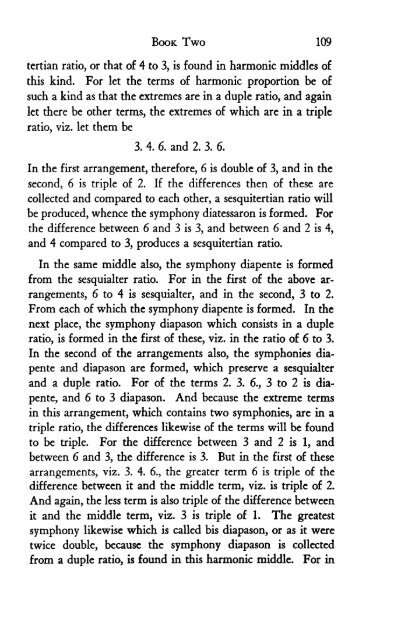Taylor - Theoretic Arithmetic.pdf - Platonic Philosophy
Taylor - Theoretic Arithmetic.pdf - Platonic Philosophy
Taylor - Theoretic Arithmetic.pdf - Platonic Philosophy
Create successful ePaper yourself
Turn your PDF publications into a flip-book with our unique Google optimized e-Paper software.
BOOK Two 109<br />
tertian ratio, or that of 4 to 3, is found in harmonic middles of<br />
this kind. For let the terms of harmonic proportion be of<br />
such a kind as that the extremes are in a duple ratio, and again<br />
let there be other terms, the extremes of which are in a triple<br />
ratio, viz. let them be<br />
3. 4. 6. and 2. 3. 6.<br />
In the first arrangement, therefore, 6 is double of 3, and in the<br />
second, 6 is triple of 2. If the differences then of these are<br />
collected and compared to each other, a sesquitertian ratio will<br />
be produced, whence the symphony diatessaron is formed. For<br />
the difference between 6 and 3 is 3, and between 6 and 2 is 4,<br />
and 4 compared to 3, produces a sesquitertian ratio.<br />
In the same middle also, the symphony diapente is formed<br />
from the sesquialter ratio. For in the first of the above arrangements,<br />
6 to 4 is sesquialter, and in the second, 3 to 2.<br />
From each of which the symphony diapente is formed. In the<br />
next place, the symphony diapason which consists in a duple<br />
ratio, is formed in the first of these, viz. in the ratio of 6 to 3.<br />
In the second of the arrangements also, the symphonies diapente<br />
and diapason are formed, which preserve a sesquialter<br />
and a duple ratio. For of the terms 2. 3. 6., 3 to 2 is diapente,<br />
and 6 to 3 diapason. And because the extreme terms<br />
in this arrangement, which contains two symphonies, are in a<br />
triple ratio, the differences likewise of the terms will be found<br />
to be triple. For the difference between 3 and 2 is 1, and<br />
between 6 and 3, the difference is 3. But in the first of these<br />
arrangements, viz. 3. 4. 6., the greater term 6 is triple of the<br />
difference between it and the middle term, viz. is triple of 2.<br />
And again, the less term is also triple of the difference between<br />
it and the middle term, viz. 3 is triple of 1. The greatest<br />
symphony likewise which is called bis diapason, or as it were<br />
twice double, because the symphony diapason is collected<br />
from a duple ratio, is found in this harmonic middle. For in
















